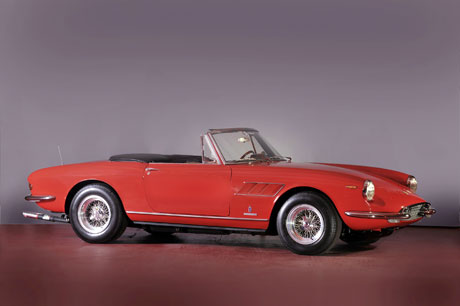SCM Analysis
Detailing
| Vehicle: | 1968 Ferrari 330 GTS |
| Number Produced: | 100 |
| Original List Price: | $16,800 |
| Tune Up Cost: | $2,500 |
| Distributor Caps: | $450, two required |
| Chassis Number Location: | Left frame member by steering box |
| Engine Number Location: | Right rear above motor mount |
| Club Info: | Ferrari Club of America PO Box 720597 Atlanta, GA 30358 |
| Website: | http://www.FerrariClubofAmerica.org |
| Investment Grade: | B |
This 1968 Ferrari 330 GTS Spyder sold for $672,620, including buyer’s premium, at the Bonhams auction in Reims, France, on September 26, 2009.
The 250 era of the late 1950s and early 1960s was the golden age for Ferrari. It was the time when the company made its name as a producer of both the best race cars and the best grand touring cars in the world. The most sought after and most valuable models were produced in this era. While the golden era brought Ferrari fame, it was the next era that brought them fortune. During the golden era, Ferrari was a race car manufacturer that built a few high-performance GTs, but soon it would be a production car company that also built race cars.
Prior to the 250 series, the largest production of any one model was the 84-example 212 Inter. In contrast, Ferrari built an impressive 955 examples of the 250 GTE 2+2. In order to increase the production to that level, Ferrari adopted standard assembly line production and began developing relationships with larger parts suppliers. There were at least 19 different 250 models, with several subsets to many of them. This was an inefficient and expensive way to build cars, and that would soon change.
Armed with the knowledge of how to build and market a production model, the next step for Ferrari was to learn how to become a car company. The 250 series was phased out in the early 1960s, replaced by the 330 series in 1963, and supplemented with the 275 series in 1964. The proliferation of models was over, replaced by standardization and economy of scale.
The 330 series homogenized the brand. The two-passenger 330 GTC coupe, 330 GTS spyder, and the four-passenger 330 GT 2+2 had no subsets. While the last 330 2+2 was much different from the first, the differences between the first and last GTC and GTS were hardly noticeable. The few 330 competition models built were so different from the street cars it’s almost a stretch to consider them part of the same family.
My previous predictions of a ceiling on 330 GTS pricing, in the $500,000 range, have, fortunately for owners, been proven wrong. I’ve always found the value of a 330 GTS Spyder to be in its drivability. Throw back the top and it’s the perfect car to take on an errand. Pack a bag or two in the good-sized trunk and it’s a wonderful car to take on a trip. It is deceptively fast, with handling to match. The transaxle shifts perfectly and the brakes are up to the job. It simply offers everything you would expect of a high-performance car of the era.
Admiring glances from adults; few thumbs up from kids
The 330 GTS Spyder is exquisitely styled and beautiful, but conservative. Its looks will garner admiring glances from the adults but few thumbs up from the kids. It’s safe in the mall parking lot, as it blends in with the crowd. If it is noticed, the conversation too often centers on its similarity to a Fiat 124.
Fun mall trips, conservative looks, and Fiat comparisons aren’t high on the list of what makes a half-million dollar car, so why would somebody lay down big green for a 330 GTS? In a word, exclusivity. There are more F40s than all the 12-cylinder Ferrari convertibles put together, and only 100 of those convertibles are 330 GTSs. While there always seem to be a couple on the market, the pickings are slim. They have always been a driver’s car and many were used hard. Finding a good one is like winning a prize.
Even in this tough market, top examples of the 330 GTS have held their own. This Bonhams sale of 11173 tops the previous highest auction sale in the SCM Platinum database. A record sale in this economy says a lot for the model and even more for the car.
As far as this car’s history, Philip Baumgarten was the money side of Bob Cressman’s Ft. Lauderdale Ferrari dealership. He had a small collection of well-kept Ferraris and the 330 was one of his favorites.
Baumgarten’s long ownership certainly helped the value of the car, as did the original accessories that have stayed with it. On the other hand, the color change to red and an aftermarket nose protection bar probably didn’t help the value. Neither did the scruffy engine compartment and an abundance of cobwebs. The underlying car was strong, but the presentation did little to add confidence that the car was ready for use.
So despite my affection for this model, and my personal satisfaction that the prices of the 330 GTS continue to rise, I still have to call this 330 GTS Spyder well sold, as the buyer paid for the best but got something a little less.
